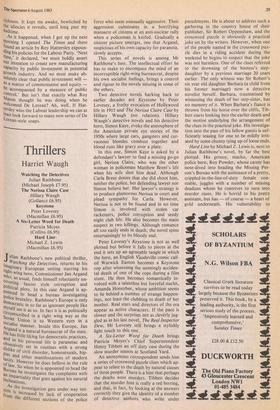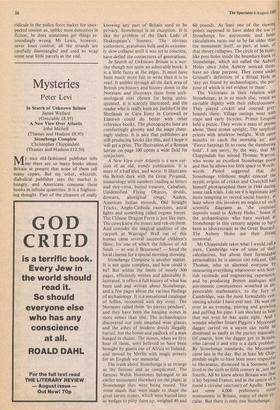Thrillers
Harriet Waugh
Jtitian Rathbone's new political thriller, Watching the Detectives, returns to his Imaginary European setting starring his right-wing hero, Commissioner Jan Argand who, as usual, finds himself reluctantly un- covering fascist style corruption and Political plots, In this case Argand is ap- Pointed to head a bureau investigating Police brutality. Rathbone's Europe is only democratic in so far as ignorant people like myself see it as so. In fact it is as politically circumscribed in a right wing way as the Soviet Union is to Western eyes in a socialist manner. Inside this Europe, Jan He is a natural bureaucrat of the state. rie has little liking for democratic practices, arid in his personal life is paranoiac and obsessively set in routines with a strong dislike of civil disorder, homosexuals, hip- Pies and other manifestations of modern laxity. However he does believe in the rule of law. So when he is appointed to head the '1" areau he investigates the complaints with ,an impartiality that goes against his natural Inclinations. As the investigation gets under way ten- sion is increased by lack of cooperation iront the different sections of the police
force who seem unusually aggressive. Their aggression culminates in a horrifying massacre of citizens at an anti-nuclear rally when a policeman is knifed. Gradually a sinister picture emerges, one that Argand, suspicious of his own capacity for paranoia, slowly accepts.
This series of novels is among Mr Rathbone's best. The intellectual effort he has to make to encompass the mind of an incorruptible right-wing bureaucrat, despite his own socialist feelings, brings a control and rigour to the novels missing in some of the others.
Two detective novels harking back to earlier decades are Keystone by Peter Lovesey, a frothy evocation of Hollywood life in 1915 and The Nerissa Claire Case by Hillary Waugh (no relation). Hillary Waugh's detective novels and his detective hero, Simon Kaye, evoke the atmosphere of the American private eye stories of the 1950s where large cars, gangsters and cur- vaceous blondes combust together and blood runs like gravy over a plate.
In this one, Simon Kaye is asked by a defendant's lawyer to find a missing go-go girl, Nerissa Claire, who was the other woman in policeman Matthew Brent's life when his wife shot him dead. Although Carla Brent denies that she did shoot him, neither the police, her defending lawyer nor Simon believe her. Her lawyer's strategy is to produce glamorous Nerissa in court and plead sympathy for Carla. However, Nerissa is not to be found and in no time Simon is involved with stolen car racketeers, police corruption and seedy night club life. He also becomes the main suspect in two killings. Although romance all too easily ends in death, the novel spins entertainingly to its bloody end.
Peter Lovesey's Keystone is not as well plotted but before it falls to pieces at the end it sets up an agreeable tangle in which the hero, an English Vaudeville comic call- ed Warwick Easton becomes a Keystone cop after witnessing the seemingly acciden- tal death of one of the cops during a film stunt. He then becomes romantically in- volved with a talentless but forceful starlet, Amanda Honeybee, whose ambition seems to lie behind a number of strange happen- ings, not least the clubbing to death of her mother. Real stars and directors of the era appear as active characters. If the pace is slower and the surprises nbt as cleverly jug- gled as in his last novel, The Real Inspector Dew, Mr Lovesey still brings a stylishly light touch to this one.
A Six-Letter Word for Death brings Patricia Moyes's Chief Superintendent Henry Tibbett an off duty case during the slow murder season at Scotland Yard.
An anonymous correspondent sends him a series of crossword puzzle clues which ap- pear to relate to the death by natural causes of three people. There is a hint that perhaps the deaths were murders. Tibbett decides that the murder hint is really a red herring, and that, in fact, by looking at the answers correctly they give the identity of a number of detective authors who write under pseudonyms. He is about to address such a gathering in the country house of their publisher, Sir Robert Oppenshaw, and the crossword puzzle is obviously a practical joke set by the writers. However, when one of the people named in the crossword puz- zle dies in a riding accident during the weekend he begins to suspect that the joke was not harmless. One of the clues referred to the drowning of the hostess's step- daughter by a previous marriage 20 years earlier. The only witness was Sir Robert's six year old daughter Barbara (a child from his former marriage) now a detective novelist herself. Barbara, traumatised by witnessing the death of her step-sister, has no memory of it. When Barbara's fiance is thrown from his horse over the cliffs, Tib- bet t starts looking into the earlier death and the motive underlying the arrangement of the clues in the practical joke. His investiga- tion into the past of his fellow guests is suf- ficiently teasing for one to be mildly irrit- ated by some clumsy tying up of loose ends.
Hard Line by Michael Z. Lewis is, next to Julian Rathbone's novel, by far the best plotted. His grousy, macho, American police hero, Roy Powder, whose career has nose-dived into heading the Missing Per- son's Bureau with the assistance of a pretty, crippled-in-the-line-of-duty female con- stable, juggles with a number of missing deaduns whom he contrives to turn into murder cases. He is horrid to his pretty assistant, but has — of course — a heart of gold underneath. His vulnerability to
ridicule in the police force makes for unex- pected tension as, unlike most detectives in fiction, he does sometimes get things re- soundingly wrong. Mr Lewis, however, never loses control; all the strands are carefully disentangled and used to wrap some neat little parcels in the end.







































 Previous page
Previous page